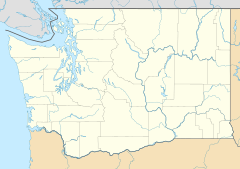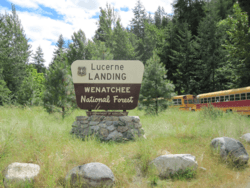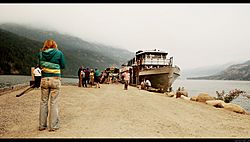Holden Village, Washington facts for kids
Holden Village is a special place in the North Cascade mountains of Washington. It's a year-round Christian center, like a peaceful camp or retreat. What makes it unique is its history. It used to be one of the biggest copper mines in the United States!
Today, you can only reach Holden Village by taking a boat across Lake Chelan. You can also hike through the beautiful Cascade Mountains. It's a large retreat center that works with the U.S. Forest Service.
Contents
Getting to Holden Village
Holden Village is tucked away in the Cascade Range in Washington. It's part of the Wenatchee National Forest. You can't drive your car directly to the village.
Most visitors take a ferry boat up Lake Chelan. The boat leaves from Chelan or Fields Point Landing. It takes you to a place called Lucerne. From Lucerne, a special bus takes you on an 11-mile (18 km) gravel road. This road has 12 sharp turns, called switchbacks. When the bus arrives, Holden staff and guests cheer to welcome you!
If you love adventure, you can also hike into Holden Village. There are several trails through the Cascade mountains that lead right to the village.
Holden Village's Past
The Mining Days (1896–1957)
The story of Holden Village began in 1896. A man named James Henry Holden found copper here. But it was very hard and expensive to move the copper from this faraway mine. So, the mine didn't really get busy until 1937.
By 1938, the mine was doing very well. It processed about 2,000 tons of copper ore every day. Many miners and their families moved here. They were looking for work after the Great Depression. The company that owned the mine, Howe Sound Company, built a whole town.
The town, called Holden, Washington, had many buildings. There were dorms, a gym, a bowling alley, a big dining hall, a school, and even a hospital. There were also small houses for miners with families. The mine and town were busy for many years, even though they were so isolated.
However, after World War II, the price of metals dropped. Also, the mine started running out of copper. So, the mine finally closed in 1957.
Becoming a Village (1961–Today)
After the mine closed, the Howe Sound Company wanted to sell the old mine and town. They asked for $100,000, but no one bought it. It was just too remote.
Then, a man named Wes Prieb had an idea. He was part of the Lutheran Bible Institute. He thought the old mine could become a spiritual retreat center. He asked the company to give it to the Lutheran Church. At first, they said no. But eventually, they agreed to sell it for just one dollar! In 1960, the land and buildings were given to the Bible school.
The buildings were old and needed a lot of work. Many were unsafe or didn't meet new building rules. But many volunteers from Lutheran churches came to help. They worked hard to fix up the village. They changed many buildings to be used for new purposes.
Soon, Holden Village started as a summer retreat center. At first, they only planned to be open in the summer. But people loved Holden Village in the winter too. So, it became a year-round retreat center.
Cleaning Up the Mine
When the Holden Mine was running, it didn't clean up its waste very well. This was common back then. For example, they dumped leftover rock and dirt, called "tailings," next to the mine. This covered many acres of wetlands.
Even though this was normal for the time, it caused problems. The area is very wild and untouched. Modern rules say you can't do this anymore. So, the U.S. Environmental Protection Agency (EPA) decided the Holden Mine area needed a big cleanup.
The old mine waste caused iron to get into Railroad Creek. This made it harder for plants and animals to live in the stream. Also, strong winds used to blow fine dust from the tailings into the air. This made the air quality bad.
Holden Village and other groups worked to fix these problems. They planted trees on the old waste piles to stop the dust. They also worked with government agencies to clean up the water. A company called Rio Tinto Group helped pay for the cleanup.
The big cleanup happened from 2011 to 2016. Holden Village still ran its programs, but also housed many construction workers. They worked day and night to clean up the mine site. Holden Village welcomed guests back for Christmas 2016 and New Year's 2017. They started normal operations again in spring 2017. There will be more testing to make sure the cleanup worked.
Holden Village Today
Today, Holden Village is a busy retreat center all year long. It relies a lot on volunteers. People from all backgrounds and faiths are welcome here.
In the summer, many families visit Holden Village. They stay for a few days, a week, or even a month. The village offers many programs in the summer. You can take classes about science, religion, art, and thinking. There are classes for all ages!
Winters are much quieter, but it's a popular spot for Christmas and New Year's. Holden Village gets a lot of snow, usually over 260 inches (6.6 meters)! This makes snowshoeing and cross-country skiing popular activities.
How to Get Around
Holden Village is still very isolated today. You still can't drive your car all the way there. Buses leave Holden Village in the morning. They drive down the mountain on those winding switchback roads.
The bus meets the boats at Lucerne, a landing on Lake Chelan. The Chelan Boat Company runs two boats, the Lady of the Lake II and the Lady Express. These boats take people up and down the lake. They stop at places like Stehekin, hiking trails, and Lucerne for Holden Village visitors.
Some visitors leave their car in Chelan and take the ferry from there. Others drive part way up the lake to Field's Point Landing. Holden Village even has a small bed and breakfast near Field's Point. It's mostly for visitors who want to use that landing.
Hiking Adventures
Besides short day-hikes around the village, you can hike to Holden Village from far away.
- A popular route starts at Phelps Creek Trail. You walk mostly flat for 5 miles (8 km). Then you climb up Spider Glacier to Spider Gap. After that, you go down through the Lyman Lakes. A clear trail then leads you into Holden along Railroad Creek.
- Hikers from the western side of the mountains can reach Holden. They hike 14 miles (23 km) up the Suiattle River Trail and Pacific Crest Trail. This takes them to Suiattle Pass. From there, it's only a 2-mile (3.2 km) hike to Lyman Lakes.
- You can also get to Holden from Stehekin. There are trails through Devore Creek and Hilgard Pass. Some trails were damaged by a fire in 2015. But trail crews have fixed them up for hiking again!

Village Community Life
Most people who live in Holden Village all year are volunteers. They have different jobs, like cooking, cleaning, or fixing equipment. Everyone lives together in a communal way. Guests also join in the volunteer spirit.
Families often live in a chalet, sometimes sharing with another family. Other residents live in dorms called lodges. Everyone eats meals together at certain times in the dining hall. Meat is not served very often.
Guests and volunteers can spend their days as they wish. But everyone is expected to come together for the evening Vespers service. There is also a Sunday service. Holden Village is famous for its Holden Evening Prayer service. A composer named Marty Haugen wrote this music when he was visiting the village in 1986.
Wildfire Challenges
Domke Lake Fire (2007)
In August 2007, a wildfire called the Domke Lake Complex Fire came close to Holden Village. About 300 guests and staff had to leave for safety. About 25 staff stayed behind to keep the village running. The fire didn't directly threaten the village. But it was close to cutting off the only road in.
During the emergency, Holden Village helped the firefighters. They gave them places to stay and meals. Six weeks later, on September 21, the village was able to welcome guests back.
Wolverine Fire (2015)
In 2015, Washington state had very dry weather. This caused many big wildfires. On June 29, 2015, lightning started a fire in Wolverine Creek. This fire grew and became part of the Chelan Complex fire.
Holden Village had to evacuate everyone again on August 1 and 2. This happened just before the fire blocked the road. A small group of 4-5 villagers stayed behind. They kept the fire sprinklers running 24 hours a day. They also cooked for the firefighters and protected the buildings. They helped clear a safe area around the village.
The Chelan Complex Fire kept spreading. It caused the Holden Bed & Breakfast to be evacuated. It also threatened the cities of Chelan and Manson. By August 28, the fire had moved away enough for some staff to return. On September 7, all villagers were allowed to come back home.
Climate
| Climate data for Holden Village, Washington, 1991–2020 normals, 1962-2020 extremes: 3218ft (981m) | |||||||||||||
|---|---|---|---|---|---|---|---|---|---|---|---|---|---|
| Month | Jan | Feb | Mar | Apr | May | Jun | Jul | Aug | Sep | Oct | Nov | Dec | Year |
| Record high °F (°C) | 58 (14) |
57 (14) |
64 (18) |
85 (29) |
91 (33) |
95 (35) |
101 (38) |
98 (37) |
96 (36) |
82 (28) |
65 (18) |
53 (12) |
101 (38) |
| Mean maximum °F (°C) | 44.5 (6.9) |
45.2 (7.3) |
54.0 (12.2) |
65.3 (18.5) |
78.9 (26.1) |
85.4 (29.7) |
91.5 (33.1) |
91.4 (33.0) |
83.0 (28.3) |
69.3 (20.7) |
49.7 (9.8) |
41.6 (5.3) |
93.4 (34.1) |
| Mean daily maximum °F (°C) | 28.2 (−2.1) |
33.8 (1.0) |
40.9 (4.9) |
49.5 (9.7) |
60.1 (15.6) |
66.4 (19.1) |
75.8 (24.3) |
75.8 (24.3) |
66.5 (19.2) |
50.8 (10.4) |
34.5 (1.4) |
27.2 (−2.7) |
50.8 (10.4) |
| Daily mean °F (°C) | 22.4 (−5.3) |
25.9 (−3.4) |
32.1 (0.1) |
39.4 (4.1) |
48.3 (9.1) |
54.4 (12.4) |
61.3 (16.3) |
61.0 (16.1) |
53.2 (11.8) |
41.4 (5.2) |
29.4 (−1.4) |
22.2 (−5.4) |
40.9 (5.0) |
| Mean daily minimum °F (°C) | 16.7 (−8.5) |
18.0 (−7.8) |
23.4 (−4.8) |
29.2 (−1.6) |
36.5 (2.5) |
42.5 (5.8) |
46.7 (8.2) |
46.3 (7.9) |
39.8 (4.3) |
32.0 (0.0) |
24.4 (−4.2) |
17.2 (−8.2) |
31.1 (−0.5) |
| Mean minimum °F (°C) | −2.0 (−18.9) |
0.1 (−17.7) |
8.2 (−13.2) |
18.9 (−7.3) |
25.9 (−3.4) |
32.5 (0.3) |
36.5 (2.5) |
35.1 (1.7) |
29.3 (−1.5) |
20.5 (−6.4) |
9.0 (−12.8) |
−0.4 (−18.0) |
−7.3 (−21.8) |
| Record low °F (°C) | −22 (−30) |
−19 (−28) |
−7 (−22) |
6 (−14) |
15 (−9) |
23 (−5) |
28 (−2) |
23 (−5) |
22 (−6) |
6 (−14) |
−10 (−23) |
−32 (−36) |
−32 (−36) |
| Average precipitation inches (mm) | 6.99 (178) |
4.64 (118) |
3.99 (101) |
1.81 (46) |
1.39 (35) |
1.24 (31) |
0.68 (17) |
0.81 (21) |
1.67 (42) |
4.38 (111) |
8.18 (208) |
7.20 (183) |
42.98 (1,091) |
| Average snowfall inches (cm) | 63.80 (162.1) |
46.90 (119.1) |
34.40 (87.4) |
4.00 (10.2) |
0.20 (0.51) |
0.00 (0.00) |
0.00 (0.00) |
0.00 (0.00) |
0.00 (0.00) |
3.20 (8.1) |
38.10 (96.8) |
83.10 (211.1) |
273.7 (695.31) |
| Average extreme snow depth inches (cm) | 69 (180) |
72 (180) |
71 (180) |
50 (130) |
18 (46) |
0 (0) |
0 (0) |
0 (0) |
0 (0) |
3 (7.6) |
24 (61) |
53 (130) |
80 (200) |
| Average precipitation days (≥ 0.01 in) | 17.4 | 14.0 | 13.8 | 9.6 | 9.8 | 8.9 | 5.0 | 5.5 | 7.9 | 14.3 | 17.1 | 18.6 | 141.9 |
| Average snowy days (≥ 0.1 in) | 15.7 | 12.6 | 10.6 | 3.4 | 0.2 | 0.0 | 0.0 | 0.0 | 0.0 | 1.7 | 11.2 | 17.4 | 72.8 |
| Source 1: NOAA | |||||||||||||
| Source 2: XMACIS2 (records, monthly max/min & snow depth) | |||||||||||||
| Climate data for Holden Village, Washington (1981–2010) | |||||||||||||
|---|---|---|---|---|---|---|---|---|---|---|---|---|---|
| Month | Jan | Feb | Mar | Apr | May | Jun | Jul | Aug | Sep | Oct | Nov | Dec | Year |
| Record high °F (°C) | 58 (14) |
57 (14) |
64 (18) |
85 (29) |
91 (33) |
101 (38) |
101 (38) |
98 (37) |
96 (36) |
82 (28) |
65 (18) |
60 (16) |
101 (38) |
| Mean maximum °F (°C) | 44 (7) |
47 (8) |
55 (13) |
65 (18) |
78 (26) |
85 (29) |
91 (33) |
91 (33) |
82 (28) |
70 (21) |
51 (11) |
43 (6) |
93 (34) |
| Mean daily maximum °F (°C) | 30.0 (−1.1) |
34.6 (1.4) |
41.4 (5.2) |
51.1 (10.6) |
61.8 (16.6) |
68.4 (20.2) |
77.8 (25.4) |
77.6 (25.3) |
68.0 (20.0) |
52.4 (11.3) |
35.4 (1.9) |
28.7 (−1.8) |
52.3 (11.3) |
| Daily mean °F (°C) | 23.4 (−4.8) |
26.3 (−3.2) |
32.5 (0.3) |
39.7 (4.3) |
48.7 (9.3) |
55.2 (12.9) |
61.8 (16.6) |
61.5 (16.4) |
53.6 (12.0) |
41.8 (5.4) |
29.9 (−1.2) |
22.4 (−5.3) |
41.4 (5.2) |
| Mean daily minimum °F (°C) | 16.8 (−8.4) |
17.1 (−8.3) |
22.5 (−5.3) |
28.4 (−2.0) |
35.5 (1.9) |
41.8 (5.4) |
46.0 (7.8) |
45.6 (7.6) |
39.1 (3.9) |
31.3 (−0.4) |
23.7 (−4.6) |
16.3 (−8.7) |
30.3 (−0.9) |
| Mean minimum °F (°C) | −3 (−19) |
0 (−18) |
8 (−13) |
19 (−7) |
26 (−3) |
31 (−1) |
36 (2) |
35 (2) |
29 (−2) |
21 (−6) |
8 (−13) |
−2 (−19) |
−9 (−23) |
| Record low °F (°C) | −22 (−30) |
−19 (−28) |
−7 (−22) |
6 (−14) |
15 (−9) |
23 (−5) |
28 (−2) |
23 (−5) |
22 (−6) |
6 (−14) |
−10 (−23) |
−32 (−36) |
−32 (−36) |
| Average precipitation inches (mm) | 5.42 (138) |
4.51 (115) |
2.96 (75) |
1.28 (33) |
0.99 (25) |
1.35 (34) |
0.65 (17) |
0.95 (24) |
1.58 (40) |
3.95 (100) |
5.43 (138) |
5.98 (152) |
35.05 (891) |
| Average snowfall inches (cm) | 90.1 (229) |
66.4 (169) |
46.7 (119) |
7.9 (20) |
0.5 (1.3) |
trace | 0.0 (0.0) |
0.0 (0.0) |
trace | 8.5 (22) |
51.1 (130) |
83.9 (213) |
355.1 (903.3) |
| Source: Desert Research Institute | |||||||||||||





